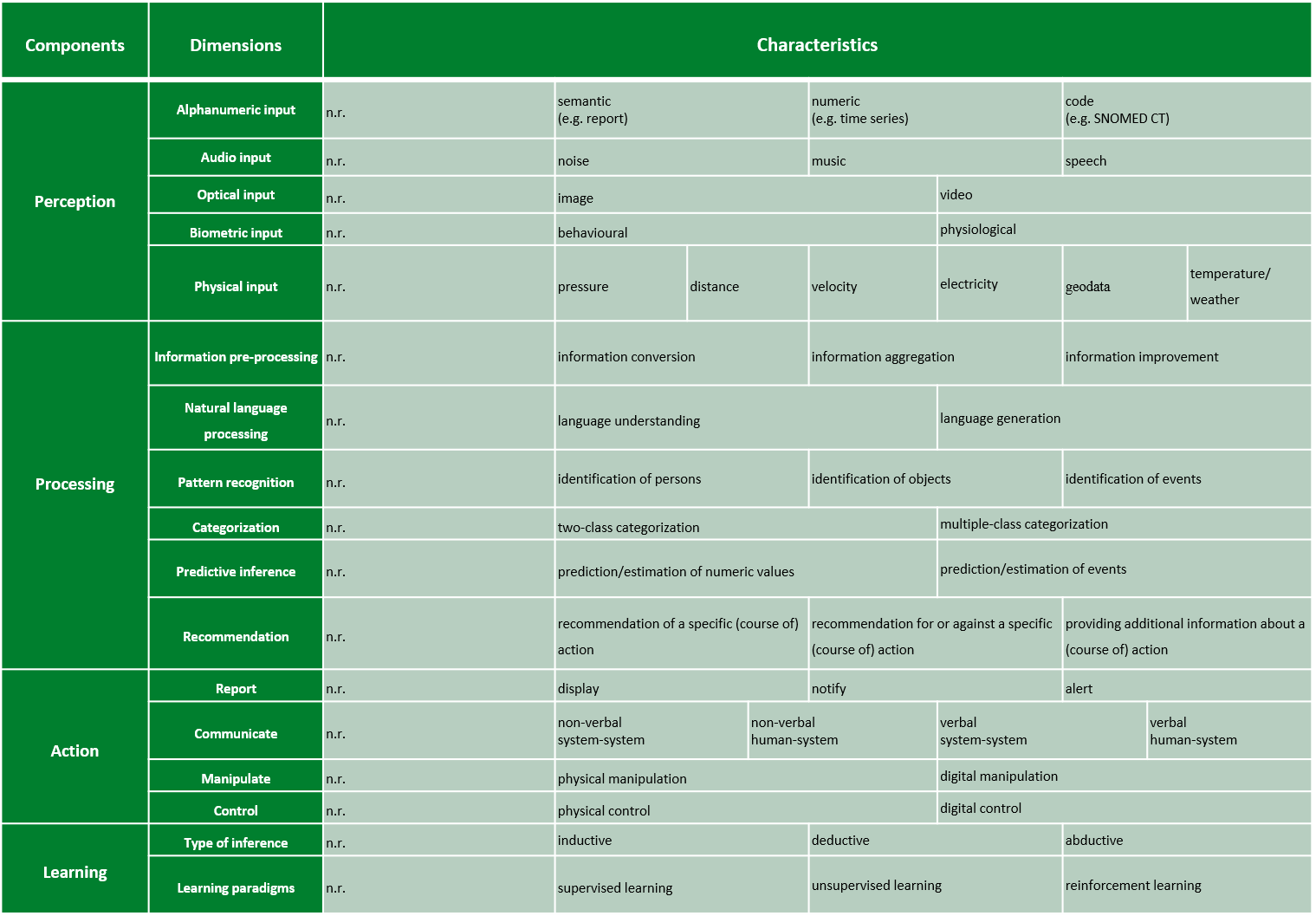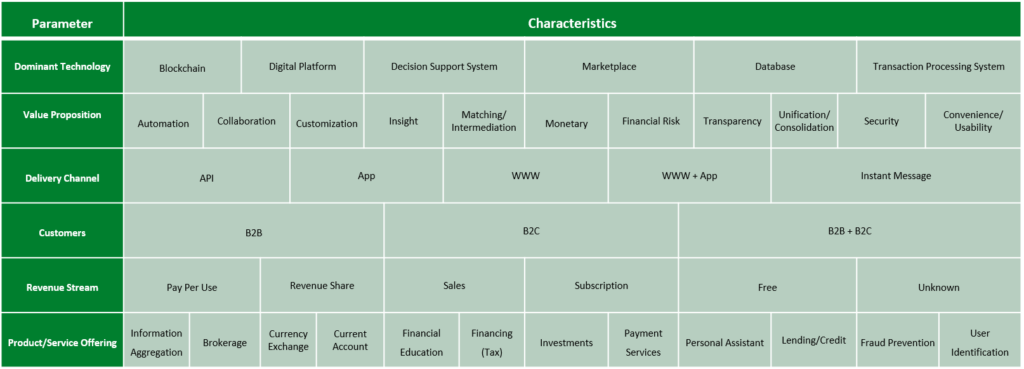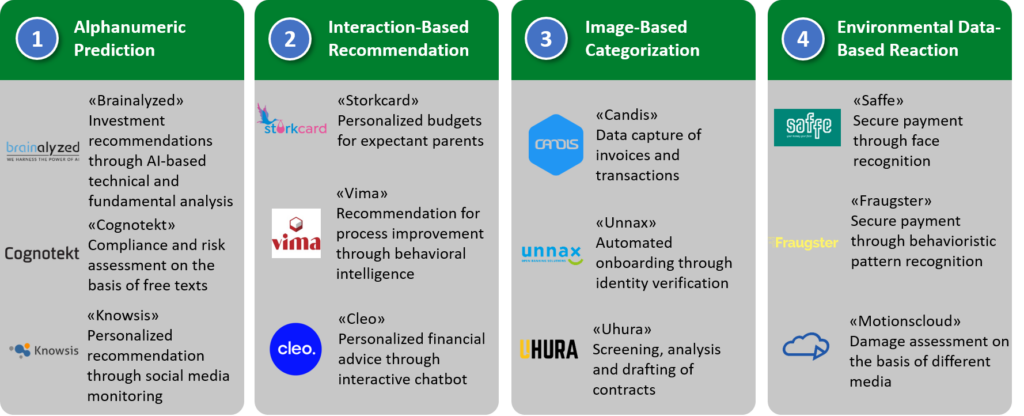
How Does Artificial Intelligence Change the Business Models of the Financial Industry? (Part 1)
Understanding AI applications is critical to success
Assessing the strategic opportunities that the use of Artificial Intelligence (AI) provides a company with requires a sound understanding of AI-based applications. Such an understanding includes not only knowledge of the possible functionalities of AI-based applications (Dietzmann & Alt, 2020), but also knowledge of the characteristics that describe these functionalities in more detail (e.g. the speech input for the speech recognition functionality can be received as an acoustic signal or be available digitally in the form of a video). Combined, these two aspects enable a detailed analysis of existing AI-based offerings, on the basis of which positioning opportunities vis-à-vis competitors in the target market can be identified. The Competence Center Ecosystems has therefore not only developed the periodic table of artificial intelligence but also the “AI Application Taxonomy”, which contains the currently observable characteristics of AI-based applications. The taxonomy enables a cross-sectoral view and is based on an iterative analysis of more than 100 AI-based applications, including applications from the finance, healthcare and automotive industries. Its goal is to make AI applications and their functionalities describable and communicable in the context of different sectors. Thus, the taxonomy can support AI project plans by allowing the project parties to use the artifact as a basis for requirements gathering – thus, a uniform vocabulary can be established, the different levels of knowledge about AI are evened out, and project communication, and therefore the results, are improved. On a strategic level, it forms the basis for the purposeful positioning of a company’s offerings.
In the current and first part of the blog post we introduce the taxonomy and then analyze a sample of European AI FinTechs. In the second part next week we will extend the analysis to the business models of AI FinTech applications in order to derive strategic positioning options for financial institutions.
Development of the AI Application Taxonomy

The “AI Application Taxonomy” builds on the AI perspective of Russell and Norvig (2016). According to this perspective, AI applications are defined as agents that receive stimuli from the environment via sensors, process them, release them to the environment again in the form of an action via actuators and then learn from the interaction. On the basis of this AI definition, the CC Ecosystems has already developed the AI Periodic Table, which structures the functions of AI along the components perception, information processing, action and learning (Dietzmann & Alt, 2020). These components are further specified in the taxonomy by a number of dimensions (see Figure 1, column 2). Thus, an AI application can perceive its environment in different ways, such as by entering text/numbers, by acoustic or optical signals, by biometric features (e.g. fingerprint) or by other physical input (e.g. pressure or speed):

Information processing may require preprocessing in the form of data aggregation or cleansing in order to process natural language, recognize patterns, assign categories based on these patterns and derive forecasts, estimates and recommendations:

The actions subsequently performed by the AI application include the communication of the results in different forms to different entities/addressees as well as the physical and digital manipulation or control of objects.

Finally, the AI-based application can learn from the data generated in the phases of perception, information processing and action by means of different types of inference and learning paradigms and thus iteratively optimize itself.

Use cases of the AI Application Taxonomy
When developing AI applications, it is particularly important that all parties involved (developers, users, decision-makers) understand what goals are being pursued with the application, in what context it is used and what it should and can achieve (Anke et al., 2020). The AI Application Taxonomy makes it possible to establish this common understanding even if the participants have different levels of knowledge, since AI applications can be characterized and modeled in a non-technical and therefore easily understandable way, even for non-computer scientists. The taxonomy can be used in the development of AI applications to:
(1) describe the functionalities of the application,
(2) derive or specify requirements for the application and
(3) select suitable AI technologies for the development of the application.
This prevents communication problems by creating a common understanding across roles and knowledge levels. In addition, trust in new AI solutions within organizations can be promoted, since the applications are made easily understandable by means of the taxonomy. Beyond the initial trust building, the AI Application Taxonomy can also be used for the continuous trust development towards the employees of an organization and to take away employees’ uncertainty towards the technology (Siau and Wang, 2018). Furthermore, the taxonomy can be used to create transparency for users and other stakeholders, such as regulators. This would not only promote a broad understanding of AI, but also lead to (hopefully) fruitful discussions on its technological potential. Furthermore, the AI Application Taxonomy is the first step towards a structured analysis of the impact of AI on business and organisational models.
Application of the taxonomy in a European AI FinTech study
The AI Application Taxonomy was applied in combination with the FinTech Business Model Taxonomy (Figure 6) developed by Eickhoff et al (2017) to analyze European AI FinTech applications and their business model characteristics and to investigate which AI applications enable which business models

For this purpose the start-up database Crunchbase was searched for the industries “FinTech” and “Artificial Intelligence”. Of the 108 hits achieved for Europe, 75 FinTechs are still on the market. These FinTechs offer 79 AI-based applications, which are the subject of the analysis. The results of the study provide insights into the current impact of AI on FinTech business models and serve as a map for managers in the financial industry to determine their own strategic positioning and future fields of action.
Analysis of the archetypes of AI applications in the FinTech sector
The AI Application Taxonomy was applied to a data set of 79 AI-based FinTech applications. At least one characteristic was selected for each dimension of the taxonomy. The completed taxonomies were then evaluated using statistical cluster analysis to identify combinations of characteristics that typically occur together. The resulting clusters yield the four application archetypes (1) Alphanumeric Prediction, (2) Interaction-Based Recommendation, (3) Image-Based Categorization, and (4) Environmental Data-Based Reaction.
At first glance, it is noticeable that the application archetypes differ primarily in their perceptual and processing properties. In the following, the individual archetypes are briefly explained: Application archetype (1) focuses on the prediction of numerical values such as stock returns or other financial ratios, archetype (2) focuses on behavioral analysis and recommendations, such as natural language processing (NLP) in the case of a personal financial assistant. Archetype (3) analyzes images of people, documents or other objects and identifies them for use cases such as payments or KYC, while Archetype (4) uses various environmental data to autonomously control or manipulate software or hardware, physically or digitally, on the basis of the insights generated from these images. On closer analysis of the archetypes, it is noticeable that from (1) Alphanumeric Prediction to (4) Environmental Data-Based Reaction, the archetypes are moving further and further away from the former classical banking business. This reflects not only the development of the banking applications themselves, but also the changing requirements of the banking industry and the new opportunities created by the increasing amount and variety of data. Figure 7 lists three exemplary FinTechs per archetype.

Deriving the application archetypes is necessary because, as mentioned above, the assessment of strategic positioning possibilities through artificial intelligence requires a sound understanding of AI-based applications in the respective market sector. Therefore the derivation of the four archetypes is the first part of the strategic analysis, the second part will follow in the next blog post. There, we will determine the business model archetypes for the European AI FinTechs and relate them to the application archetypes to ultimately identify strategic positioning options.
References
Anke, J., Poeppelbuss, J. & Alt, R. (2020). Joining Forces: Understanding Organizational Roles in Inter-organizational Smart Service Systems Engineering. In N. Gronau, H. Krasnova, K. Pousttchi, M. Heine (Eds.). Proceedings der 15. Internationalen Tagung Wirtschaftsinformatik. Berlin: GITO Verlag.
Dietzmann, C., & Alt, R. (2020). Assessing the business impact of Artificial Intelligence. In T. X. Bui (Ed.). Proceedings of the 53rd Hawaii International Conference on System Science (pp. 5170-5179). Retrieved from http://hdl.handle.net/10125/64377
Eickhoff, M., Muntermann, J. & Weinrich, T. (2017). What do FinTechs actually do? A Taxonomy of FinTech Business Models. In Y. J. Kim, R. Agarwal & J. K. Lee (Hrsg.). ICIS 2017 Proceedings. 22. Retrieved from https://aisel.aisnet.org/icis2017/EBusiness/Presentations/22/
Russell, S. J. & Norvig, P. (2016). Artificial intelligence: a modern approach. Malaysia: Pearson Education Limited.
Siau, K. & Wang, W. (2018). Building trust in artificial intelligence, machine learning, and robotics. Cutter Business Technology Journal, 31(2), 47-53. Retrieved from https://www.cutter.com/article/building-trust-artificial-intelligence-machine-learning-and-robotics-498981
